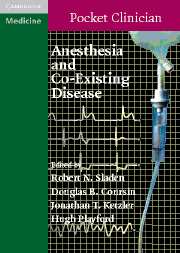Preface
Published online by Cambridge University Press: 10 November 2010
Summary
Anesthesia and Co-existing Disease provides a timely, rapid overview of common and uncommon co-morbidities that are encountered in the day-to-day practice of anesthesiology. It provides a guide to the perioperative assessment and anesthetic management of patients with widely prevalent co-morbidities such as hypertension, diabetes, obesity, myocardial ischemia, and kidney and liver disease. It concisely outlines priorities for patients with special problems who are undergoing unrelated operative procedures, such as the obstetrical patient, the patient with prior organ transplantation, the adult patient with congenital heart disease, the spinal cord injured patient, the cancer patient with prior chemotherapy, the critically ill patient, or the patient with a psychiatric disorder. It also focuses on specific challenges to the anesthesiologist, such as patients with latex allergy, a history of substance abuse, preoperative use of herbal medications, or those who are at risk of malignant hyperthermia.
This text consists of 57 individual chapters with a structured outline format that starts with a description of the disease or condition. Subsections address its impact on fluid and electrolyte management, the cardiopulmonary system, hematologic reserve, gastrointestinal function, metabolism and nutrition, neurologic and psychiatric function. Next, the pharmacologic implications – pharmacokinetic and pharmacodynamic – enumerated. In the third component, subsections tackle preoperative evaluation, risk stratification, and preparation; intraoperative priorities, preparation, monitoring, and care; and finally postoperative management, pain control, PACU issues, and intermediate care or ICU requirements and indications.
- Type
- Chapter
- Information
- Anesthesia and Co-Existing Disease , pp. xiii - xivPublisher: Cambridge University PressPrint publication year: 2007



